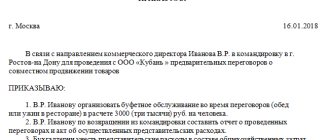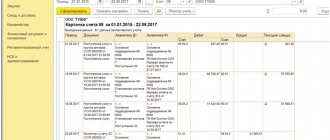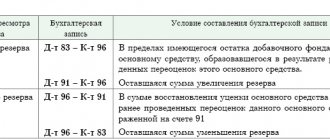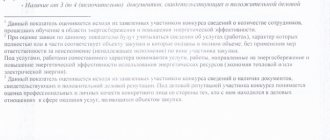Accounting error
Errors identified during the preparation of annual financial statements are subject to mandatory correction.
The procedure for correcting errors made in accounting is contained in PBU 22/2010 (approved by order of the Ministry of Finance dated June 28, 2010 No. 63n).
An error is the incorrect reflection or failure to reflect the facts of economic activity in the accounting records or financial statements of the company. Inaccuracies or omissions in the reflection of facts of economic activity in accounting and reporting, identified as a result of obtaining new information that was not available to the organization at the time of reflection of such facts of economic activity (clause 2 of PBU 22/2010), are not considered errors.
Errors are divided into significant and insignificant.
An error is considered significant if it, individually or in combination with other errors for the same reporting period, can affect the economic decisions of users that they make on the basis of the financial statements for this period (clause 3 of PBU 22/2010). Each company sets the criterion of materiality in its accounting policies independently. One would be the generally accepted materiality level of 5%.
Accounting
Clause 10 of the Accounting Regulations 9/99 establishes that the amount of proceeds from the sale of fixed assets, interest for the use of the enterprise’s finances, and income from participation in the capital of other legal entities is determined in a manner similar to income from core activities. Fines are taken into account in the amounts specified in the court decision or settlement agreement with the debtor. The value of gratuitously received assets is accepted as market value.
Creditor amounts are included in income at the price indicated in the accounting records. Other income is accounted for based on the actual amounts appearing in the accounting documentation at the time of declaration. Additional assessment of assets is carried out according to the rules established for such cases.
An example of how income received by an enterprise from renting out property is accounted for in accounting.
Dt 76.5, 62.1 Kt 91.1 – the amount of income for the leased property was accrued
Dt 91.2 Kt 68.2 – VAT charged
Dt 50.1 Kt 76.5 – accounting of cash receipts to the company’s account from the tenant of the property was made.
However, there are exceptions to the accounting rules that apply to some cases of non-core income of the enterprise. For example, fixed assets received free of charge are accounted for in account 98. That is, account 91 is used to account for income that has a direct monetary value. Ideally, the amounts of non-operating income (tax accounting) should coincide with similar income included in PBU as other income. This should be carefully monitored due to the fact that regulatory organizations have the right to verify the correctness of the attribution of income to tax and accounting records.
The difference, that is, those other accounting incomes that are not included in non-operating income for tax accounting, is the amount under Article 251 of the Tax Code. From an economic point of view, the income indicated in it does not increase the company’s benefits from directly conducting business, that is, they are not taken into account when determining the income portion and drawing up a declaration.
How to correct errors in accounting
The procedure for correcting errors in accounting depends on whether they are significant or immaterial and at what point they were discovered. There can be 6 such options.
1. Error in the reporting year identified before its end
An error in the reporting year identified before its end is corrected by adding adjusting entries in the month in which it was identified. The results of corrections are taken into account when compiling annual financial statements.
2. An error in the reporting year discovered after its end but before the date of signing the annual reports
If an error for the reporting year is discovered at the beginning of the next year when preparing annual financial statements, you need to make adjustment entries in December of the previous year. Entries are made on the same accounting accounts on which this transaction should usually be reflected.
3. A significant error from the previous year, identified after the date of signing the annual reports, but before the date of their presentation to the owners of the company
This error is corrected in the same manner as in the previous situation. That is, they make adjustment entries dated December of the previous year. Moreover, if the signed annual statements have already been submitted to some other users (for example, to the tax office, bank, etc.), then corrected financial statements should be submitted instead.
4. A significant error from the previous year, identified after the submission of annual reports to the owners of the company, but before the date of approval of these reports
And in this case, a significant error is corrected by adjusting entries dated December of the previous year. Corrected financial statements must be submitted to all addresses where the original financial statements were submitted. In addition, explanations are drawn up for the corrected financial statements, which indicate the reasons for adjusting these statements.
5. Significant error from the previous year, identified after approval of the annual reports
But the approved annual reports cannot be corrected (clause 10 of PBU 22/2010).
If a significant error of the previous year was discovered after the approval of the financial statements, it is corrected directly in the current reporting period in which it was discovered (clause 9 of PBU 22/2010). In this case, the corresponding account in the corrective entries should be account 84 “Retained earnings (uncovered loss)”.
Then you should recalculate the corresponding indicators of previous reporting periods, which are reflected in the financial statements of the current year in which the error was discovered, as if this error had never been made. This method of editing is called retrospective recalculation.
For example, if an error made in 2020 is identified in 2022, only the reporting indicators for 2022 need to be adjusted. In this case, the opening balance as of January 1, 2022 must be recalculated in the balance sheet, as if the inaccuracy in 2022 had not been made. And in the financial statements, you will need to change the comparative data for all similar periods, starting with the one in which the error was made.
6. Insignificant error of the previous year, identified after the date of signing of the annual reports
An insignificant error from last year, discovered after the signing of the financial statements for the year, is corrected in the month of the current year in which it was discovered. At the same time, profits (losses) of previous years, which appear when such errors are corrected, are written off to other income and expenses of the current reporting period by entries in account 91 “Other income and expenses” (clause 14 of PBU 22/2010). Thus, minor errors participate in the formation of the financial result of the current year.
When correcting minor errors, the signed financial statements of the previous year are not revised, and comparative indicators for previous reporting years are not adjusted.
Accounting for non-operating financial results.
91- below wiring
Non-operating income is:
fines, penalties, penalties for violation of contract terms, assets; proceeds received free of charge, including under a gift agreement, to compensate for losses caused to the organization; profit of previous years identified in the reporting year; amounts of accounts payable and depositors for which the statute of limitations has expired; positive exchange rate differences; the amount of revaluation of assets; other non-operating income.
Non-operating expenses are:
fines, penalties, penalties for violation of contract terms; compensation for losses caused by the organization; losses of previous years recognized in the reporting year; amounts of receivables for which the statute of limitations has expired, and other debts that are unrealistic for collection; negative exchange rate differences; the amount of asset depreciation; transfer of funds (contributions, payments, etc.) related to charitable activities, expenses for sporting events, recreation, entertainment, cultural and educational events and other similar events; other non-operating expenses.
Non-operating income and expenses are recorded in account 91 “Other income and expenses”. Subaccount 91-1 “Other income” reflects the amounts of non-operating income. On subaccount 91-2 “Other expenses” - non-operating expenses.
Accounting for non-operating income.
1. The amount of the fine for failure to fulfill contractual obligations is reflected:
Debit of account 51 “Settlement accounts” Credit of account 91 “Other income and expenses”, subaccount “Other income”.
2. Write-off of accounts payable: Debit account 76 “Settlements with various debtors and creditors”, account 60 “Settlements with suppliers and contractors”
Credit to account 91 “Other income and expenses”, subaccount “Other income”.
3. The amount of positive exchange rate differences is reflected:
Debit account 52 “Currency accounts”
Credit to account 91 “Other income and expenses”, subaccount “Other income”.
Accounting for non-operating expenses.
1. Funds were transferred from the organization’s current account to pay penalties for violation of the terms of the agreement for the supply of finished products:
Debit of account 91 “Other income and expenses”, subaccount “Other expenses” Credit of account 51 “Current accounts”.
2. Write-off of accounts receivable:
Debit account 91 “Other income and expenses”, subaccount “Other expenses”
Credit to account 62 “Settlements with buyers and customers”, account 76 “Settlements with various debtors and creditors”.
3. The amount of markdown of finished products is shown:
Debit account 91 “Other income and expenses”, subaccount “Other expenses”
Credit to account 43 “Finished products”.
The final financial result is reflected in the following entry:
Debit of account 99 “Profits and losses” (91 “Other income and expenses”, subaccount “Balance of other income and expenses”)
Credit to account 91 “Other income and expenses”, subaccount “Balance of other income and expenses” (99 “Profits and losses”).
Write-off of non-operating income is reflected:
Debit account 91 “Other income and expenses”, subaccount “Other income”
Credit to account 90 “Sales”, subaccount “Profit (loss) from sales”.
Write-off of non-operating expenses:
Debit account 90 “Sales”, subaccount “Profit (loss) from sales”
Credit to account 91 “Other income and expenses”, subaccount “Other expenses”.
Contents and procedure for accounting for receivables and payables. Accounting for write-off of receivables and payables.
76- postings below
Receivables are understood as the debt of other organizations, employees and individuals of this organization (debt of buyers for purchased products, accountable persons for amounts of money issued to them on account, etc.). Organizations and persons who owe this organization are called debtors.
Accounts payable refers to the debt of a given organization to other organizations, employees and persons who are called creditors.
In the balance sheet, receivables and payables are reflected by their types. Accounts receivable are reflected mainly in accounts 62 “Settlements with buyers and customers”, 76 “Settlements with various debtors and creditors”, and accounts payable - in accounts 60 “Settlements with suppliers and contractors”, 76 “Settlements with various debtors and creditors”.
The following sub-accounts can be opened for account 76:
· 76-1 “Calculations for property and personal insurance”;
· 76-2 “Calculations for claims”;
· 76-3 “Calculations for due dividends and other income”;
· 76-4 “Calculations for deposited amounts”, etc.
On the sub-account 76-1
“Calculations for property and personal insurance” reflect calculations for insurance of property and personnel of an organization in which the organization acts as an insured.
The accrued amounts of insurance payments are reflected on the credit of account 76, subaccount 1 “Calculations for property and personal insurance”, in correspondence with the accounts of production costs or other sources of insurance payments (08, 23, 25, 26, 29, etc.) .
The listed amounts of insurance payments to policyholders are written off from the credit of cash accounting accounts (51, 52, 55) to the debit of account 76-1.
Losses of commodity and material assets due to insured events are written off from the credit of accounts 10, 43, etc. to the debit of account 76-1. The debit of account 76-1 reflects the amount of insurance compensation due under the insurance contract to an employee of the organization (credit account 73 “Settlements with personnel for other operations”).
The amounts of insurance compensation received by the organization from insurance organizations are reflected in the debit of cash accounting accounts (51, 52, 55) and the credit of account 76-1. Losses from insured events that are not compensated by insurance compensation are written off as a debit to account 91 “Other income and expenses.”
Analytical accounting for account 76-1 is carried out by insurers and individual insurance contracts.
On the sub-score 76-2
“Calculations for claims” reflect calculations for claims presented to suppliers, contractors, transport and other organizations, as well as for fines, penalties and penalties imposed and recognized (or awarded). To the debit of this account, damage caused to the organization due to the fault of suppliers of material resources, contractors, banking institutions and other organizations is written off from the credit of the following accounts:
· 60 “Settlements with suppliers and contractors” – for the amounts of discrepancies in prices and tariffs, quality, arithmetic errors, etc. according to already capitalized assets;
· 20 “Main production”, 23 “Auxiliary production” and other cost accounting accounts - for defects and losses caused by the fault of suppliers and contractors;
· accounting of funds and bank loans (51, 52, 66, 67, etc.) - for amounts erroneously written off from the organization’s accounts;
· 91 “Other income and expenses” – for fines, penalties, penalties collected from suppliers, contractors, buyers, customers, consumers of services for non-compliance with contractual obligations.
The amounts of satisfied claims are written off from the credit of account 76-2 to the debit of cash accounting accounts (51, 52, etc.). Amounts of unsatisfied claims, as a rule, are written off from the credit of account 76-2 to the debit of those accounts from which they were written off to account 76-2 (10, 20, 23, 60, etc.).
Various fines, penalties and penalties paid by the organization are written off from the credit of cash accounting accounts to the debit of account 91 “Other income and expenses”.
On the sub-score 76-3
“Calculations for dividends due and other income” take into account calculations for dividends and other income due to the organization, including profits, losses and other results under a simple partnership agreement. Receivable income is reflected in the debit of account 76-3 and the credit of account 91 “Other income and expenses”. The income received is recorded in the debit of asset accounting accounts (51, 52, etc.) and the credit of account 76-3.
On the sub-score 76-4
“Settlements for deposited amounts” take into account settlements with employees of the organization for amounts not paid on time due to the non-appearance of recipients. The deposited amounts are reflected in the credit of account 76-4 and the debit of account 70 “Settlements with personnel for wages”. When paying the deposited amounts to the recipient, cash accounting accounts are credited and account 76-4 is debited.
Analytical accounting for account 76 “Settlements with various debtors and creditors” is carried out for each debtor and creditor. The balance of account 76 is determined from the turnover sheet for the analytical accounts of account 76.
Accounting for settlements with various debtors and creditors within a group of interrelated organizations, about whose activities consolidated financial statements are compiled, is kept separately on account 76.
After the expiration of the limitation period, receivables and payables are subject to write-off. The general limitation period is set at three years. For certain types of claims, the law may establish special limitation periods, shorter or longer than the general period.
The limitation period begins to be calculated at the end of the period for fulfillment of obligations, if defined, or from the moment when the creditor has the right to make a claim for the fulfillment of the obligation.
Accounts receivable for which the statute of limitations has expired, as well as other unrealistic debts, are written off for each obligation incurred. To do this, it is necessary to conduct an inventory, and based on its results and the decision of the manager in writing, the debt can be written off. In accounting in accordance with clause 77 of the Accounting Regulations, accounts receivable for which the statute of limitations has expired and other unrealistic debts can be written off using one of the following methods :
· on the financial results of the organization’s activities (if debt amounts were not reserved);
· through the reserve for doubtful debts.
Please note: recognizing debts as a loss does not entail cancellation of the debt. This debt must be accounted for in off-balance sheet account 007 “Debt of insolvent debtors written off at a loss” for 5 years, which, unfortunately, many people forget about (Debit 007 - for the amount of debt). According to the Chart of Accounts, analytical accounting on an off-balance sheet account is maintained for each debtor whose debt is written off at a loss, as well as for each debt written off at a loss.
If, after writing off the receivable, the buyer repays it, the funds received will be non-operating income. In this case, the amount of the repaid debt is written off from the off-balance sheet account (Credit 007 - for the amount of the debt). An entry on the credit of account 007 is also made if the five-year monitoring period for the specified debt has expired and the possibility of collecting it has been completely exhausted.
Let's consider the accounting procedure if the reserve was not created.
If the debt amounts were not reserved, then the organization, according to the Chart of Accounts, writes off the receivables from the settlement account 62 “Settlements with buyers and customers”, 76 “Settlements with various debtors and creditors” to the debit of account 91 “Other income and expenses”, subaccount “Other” expenses". This rule is based on the norms of paragraph 11 of PBU 10/99, according to which the amounts of receivables for which the statute of limitations has expired, as well as other unrealistic debts, are non-operating expenses of the organization.
Income tax
For the purpose of calculating income tax, income of previous years identified in the reporting (tax) period is recognized as non-operating income (clause 10 of Article 250 of the Tax Code of the Russian Federation), but they are included in the income of the identification period only if the period to which these incomes are included.
If the period of receipt of income is known, then, in accordance with Article 54 of the Tax Code of the Russian Federation, in the general case, recalculation is made for the period in which an error (distortion) was made in determining the tax base. The general procedure for correcting errors made in the tax base for income tax is prescribed in Article 54 of the Tax Code of the Russian Federation.
At the same time, you can correct an error that led to excessive payment of tax in the current period (Clause 1, Article 54 of the Tax Code of the Russian Federation). But only if a profit was made in the current period. If, based on the results of the current reporting (tax) period, the company suffered a loss, that is, the tax base is zero, it is impossible to recalculate the zero base. This means that you need to recalculate the tax base for the period in which the error occurred.
The updated declaration must be submitted in the form that was in force during the period when the error was made in determining the tax base (Article 81 of the Tax Code of the Russian Federation).
To avoid a fine under Article 122 of the Tax Code of the Russian Federation, before submitting an updated declaration, you must pay the additional amount of tax and penalties.
List of non-operating income
Another approach to determining this form of profit is to list the possible types of income that Art. 250 Tax Code classifies as non-operating:
- profit received from equity participation in other associations (if additional shares are purchased with dividends, then this income is excluded from non-operating income);
- penalties, fines, penalties paid to the company under contracts (or even not yet paid, but only awarded or recognized by the debtor);
- compensation received for damage or loss;
- insurance payments;
- profit from leasing or subletting tangible assets or real estate (except for those situations when this activity is the main activity for the company - then this is already income from the provision of services);
- assets received free of charge, for example, as a gift;
- past profit for the reporting year;
- the cost of surplus property credited to the balance sheet based on the results of the regular inventory;
- payment of debts on loans and deposits, the statute of limitations of which has already expired (“unexpectedly returned debt”);
- profit from differences in exchange rates;
- the result of revaluation of assets;
- some others.
Examples of errors in determining non-operating income
- Compensation for losses
Taxpayers often have great difficulties when calculating tax (income tax or simplified tax system) on the insurance compensation received. These amounts are quite often not taken into account by taxpayers as part of non-operating income, since they believe that, having lost property or suffered losses from an insured event and received (often only partial) compensation from the insurer, they do not have to pay tax.
But this is not so: even if, as a result of an insured event, property was completely lost or it was recognized as not subject to restoration, the insurance compensation received must be included in income and taken into account when determining the tax base. In support of this position, there are explanations from the fiscal authorities contained in the letter of the Federal Tax Service dated November 15, 2005 No. [email protected]
A similar situation arises in the case of compensation to a taxpayer who has suffered from theft for damages to those convicted of this crime.
- Free transfer
If a taxpayer receives services for the reconstruction of assets on his balance sheet free of charge, he is obliged to reflect these services as part of non-operating income. The cost of services is calculated as the market average, but not lower than the costs incurred in accordance with Art. 105.3 Tax Code of the Russian Federation. However, the taxpayer will not be able to increase the value of the assets improved as a result of the reconstruction, since he did not actually incur any costs.
- Decrease in capital
Taxpayers have many questions in situations where the size of the authorized capital (hereinafter referred to as the authorized capital) is reduced to a value less than the value of net assets. The position here is ambiguous, not only because of the existing nuances, but also due to the existing ambiguous judicial practice.
In the event of a decrease in the authorized capital and non-repayment of the cost of correction (reduction in the price of shares or shares) to participants, the tax payer company has an obligation to reflect the resulting difference in the composition of non-operating income. The arbitrators also adhere to the same position - a similar explanation can be found in the ruling of the Supreme Arbitration Court of the Russian Federation dated October 13, 2009 No. VAS-11664/09.
By paying the participants/shareholders the difference in the value of shares/shares, the taxpayer company is relieved of the obligation to accrue non-operating income from these amounts.
An exception to the rules is the situation when such a reduction of the capital (to the amount of net assets) is carried out as required by law (letter of the Ministry of Finance dated 08/06/13 No. 03-03-10/31651).
If the size of the capital decreases below the value of the company’s net assets, in any case, non-operating income will arise in the amount of this discrepancy. There is a position of the fiscal authorities on this matter (letter of the Federal Tax Service dated 09/06/12 No. AS-4-3/ [email protected] ) and positive judicial practice (resolution of the Federal Antimonopoly Service of North Kazakhstan Region dated 04/07/08 No. F08-1417/08-503A).
Although the letter of the Ministry of Finance dated 08/06/13 No. 03-03-10/31651 indicates that in this case there is no need to accrue non-operating income. Therefore, in order to avoid the emergence of controversial situations, the size of the charter capital should not be allowed to decrease below the value of net assets.
- Overdue accounts payable
Any overdue or unclaimed accounts payable by the liquidated counterparty must be reflected as part of non-operating income. At the same time, it is the direct responsibility of taxpayers to track and inventory such debt. As evidence of this position, one can cite a court decision - resolution of the Federal Antimonopoly Service of the Central District dated June 18, 2015 No. F10-1759/2015.
At the same time, the inspectors do not take into account the absence of an order from the director to write off such accounts payable while simultaneously recording the amount as income. This is stated in the resolution of the Presidium of the Supreme Arbitration Court of the Russian Federation dated 06/08/2010 No. 17462/09.
- Penalties under the contract
The situation with the penalties specified in the contract is also ambiguous. Thus, in case of failure to fulfill contractual obligations, one of the parties has the right to impose a fine on the violator. At the same time, the specified amounts of fines are included in income only if the debtor recognizes the calculated amount of fines or there is a corresponding court decision.
The position of the inspection authorities is that if the parties have signed an agreement containing a provision for the application of penalties, then in the event of failure to fulfill obligations, the amount of the penalty is calculated automatically (letter dated August 26, 2013 No. 03-03-06/2/34843). This position was recognized by the court as illegal (decision of the Supreme Arbitration Court of the Russian Federation dated August 14, 2003 No. 8551/03).
In addition, the court decision (resolution of the 12th AAS dated February 17, 2015 No. 12AP-12462/2014) indicates that fiscal officials cannot recognize accounts payable without the necessary primary documents.






